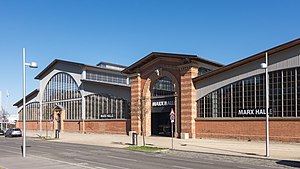Marx hall
| Marx hall | |
|---|---|
| The Vienna Marx Hall | |
| Earlier names | |
|
Cattle sales hall, cattle hall |
|
| Data | |
| place | Karl-Farkas-Gasse 19 1030 Vienna , Austria |
| Coordinates | 48 ° 11 '14.7 " N , 16 ° 24' 19.5" E |
| operator | HEY-U media group |
| start of building | 1878 |
| opening | 1881 (2014) |
| architect | Rudolf Frey |
| capacity | 8,000 standing places |
The Marx Halle , historically Rinderhalle St. Marx , is a listed event location in Vienna's 3rd district, Landstrasse. Until the Vienna Central Cattle Market was relocated in 1997, the steel structure served as a sales and market hall for cattle. From 1999 the now vacant building was used as an event location. This subsequent use of the building, which continues to this day, was only interrupted by renovation work and structural adaptations. In total, the Marx Halle comprises four separately playable rooms on a total area of 20,000 square meters.
history
The construction of the cattle sales hall was decided as a central component of the new Vienna Central Cattle Park in 1877 in the municipal council of the then imperial capital and residence city of Vienna and was headed by the architect Rudolf Frey from 1879 . The hall was built in two stages. In the first section, the hall was dimensioned to hold 4000 cattle. Only after the abandonment of the remaining emergency stables was the capacity to be expanded to 5350 cattle.
On October 25, 1879 started construction, the handover on December 2, 1880. In early January 1881 was the first beef cattle exhibition in the presence of Emperor Franz Joseph I instead. When it opened, the hall had a capacity of 4,500 cattle.
Extension in 1898
The expansion of the building to a capacity of up to 6000 cattle was decided on June 30, 1898 in the Vienna City Council and implemented that same year. To increase the capacity, the hall was extended by six axes.
World wars
During the First World War the hall was used as quarters for horses and crew. During the Second World War it was used as a military camp. During the Second World War, the entire central cattle market and the cattle sales hall were badly damaged. In the course of the reconstruction between 1947 and 1949, among other things, the roof of the hall was completely renewed.
Closure of the slaughterhouse
The cattle sales hall served as a market hall until the final closure of the St. Marx slaughterhouse on December 31, 1997. Shortly beforehand, the hall, the administration building and the bank building were listed on April 3, 1997. At this time the first ideas for a future use of the now listed building came up.
After the first temporary use in 1999 for events, the hall was completely renovated between 2006 and 2007 by WSE Wiener Stadtentwicklungsgesellschaft mbH, a Wien Holding company . From 2011 the hall was gradually expanded into a modern, multifunctional event hall together with the operator, HEY-U Mediagroup. When full operation began in 2014, the name Marx Halle was introduced. Also in 2014, the cabaret theater Globe Vienna , directed by Michael Niavarani and Georg Hoanzl, was built in the Marx Halle. At the beginning of 2018, the use of the hall and further operation until 2084 were fixed.
building
The basilical hall was executed as a wrought iron construction. At the time of its construction, the hall was considered an outstanding structural achievement due to its lightweight construction. The originally 224 m long, 175 m wide and 17 m high hall consists of two three-aisled halls, which are connected along their long sides by a roofed intermediate hall. For the expansion of the A 23 in 1980 and 2003, the hall was shortened to 175 m. With the transfer of the former St. Marx Zentralviehmarkt area to the Wiener Stadtentwicklungsgesellschaft mbH (WSE) owned by Wien Holding , the first substance-preserving renovation work was carried out in 2000 and a general renovation between 2006 and 2007.
Web links
- Website of the Marx Halle
- Entry of the Marx Halle on the website of the Vienna Convention Bureau
- The St. Marx cattle hall
Individual evidence
- ↑ Start of the renovation work on the cattle hall St. Marx , OTS of the PID-Rathauskorrespondenz, July 12, 2006
- ^ The municipal administration of the Reichsgau Vienna, Volume 1877–1879, XV. Market and Approvisioning System, p. 661
- ^ The municipal administration of the Reichsgau Vienna, Volume 1880-1882, XV. Market and approval system, p. 751
- ↑ Die Presse, January 10, 1881
- ^ The municipal administration of the Reichsgau Vienna, Volume 1897, XVI. Market and Approvisioning System, p. 185
- ^ The municipal administration of the Reichsgau Vienna, Volume 1914-1919, Nutrition and Economic Affairs, p. 455
- ↑ The municipal administration of the Reichsgau Vienna, Volume 1938, Municipal Enterprises and Economic Affairs, p. 77
- ^ Official Journal of the City of Vienna, Volume 1950, No. 89 / November 8, 1950
- ^ History of the Globe Vienna
- ↑ Marx Halle: Previous tenant, only slightly changed concept , courier, 10.01.2018
- ↑ [1]
- ↑ https://www.wse.at/tools/uploads/z_presse_inhalte_32_wse_stm_handout_low.pdf WSE information brochure on renovation


